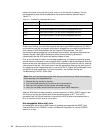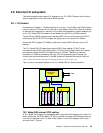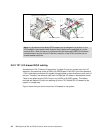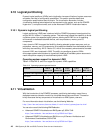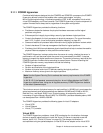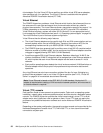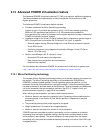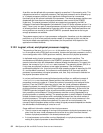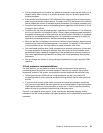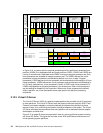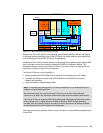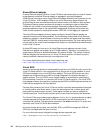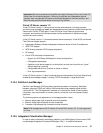
50 IBM System p5 520 and 520Q Technical Overview and Introduction
client adapter. Only the Virtual I/O Server partition can define virtual SCSI server adapters,
other partitions are
client partitions. The Virtual I/O Server is available with the optional
Advanced POWER Virtualization feature (FC 7940).
Virtual Ethernet
The POWER Hypervisor provides a virtual Ethernet switch function that allows partitions on
the same server to use a fast and secure form of communication without any need for
physical interconnection. The virtual Ethernet allows a transmission speed in the range of 1 to
3 GBps. depending on the maximum transmission unit (MTU) size and CPU entitlement.
Virtual Ethernet requires a system with either AIX 5L Version 5.3 or an appropriate level of
Linux supporting virtual Ethernet devices (see 2.14, “Operating system support” on page 64).
The virtual Ethernet is part of the base system configuration.
Virtual Ethernet has the following major features:
The virtual Ethernet adapters can be used for both IPv4 and IPv6 communication and can
transmit packets with a size up to 65408 bytes. Therefore, the maximum MTU for the
corresponding interface can be up to 65394 (65390 if VLAN tagging is used).
The POWER Hypervisor presents itself to partitions as a virtual 802.1Q compliant switch.
Maximum number of VLANs is 4096. You can configure virtual Ethernet adapters as either
untagged or tagged (following IEEE 802.1Q VLAN standard).
A partition supports 256 virtual Ethernet adapters. Besides a default port VLAN ID, the
number of additional VLAN ID values that can be assigned per virtual Ethernet adapter is
20, which implies that each virtual Ethernet adapter can be used to access 21 virtual
networks.
Each partition operating system detects the virtual local area network (VLAN) switch as an
Ethernet adapter without the physical link properties and asynchronous data transmit
operations.
Any virtual Ethernet can also have connection outside of the box if a layer-2 bridging to a
physical Ethernet adapter is set in one Virtual I/O Server partition (see 2.12.3, “Virtual I/O
Server” on page 54 for more details about shared Ethernet).
Virtual (TTY) console
Each partition needs to have access to a system console. Tasks such as operating system
installation, network setup, and some problem analysis activities require a dedicated system
console. The POWER Hypervisor provides the virtual console using a virtual TTY or serial
adapter and a set of Hypervisor calls to operate on them. Virtual TTY does not require the
purchase of any additional features or software such as the Advanced POWER Virtualization
feature.
Depending on the system configuration, the operating system console can be provided by the
Hardware Management Console virtual TTY, IVM virtual TTY, or from a terminal emulator
connected to a system port.
Note: Virtual Ethernet is based on the IEEE 802.1Q VLAN standard. No physical I/O
adapter is required when creating a VLAN connection between partitions, and no access to
an outside network is required.



